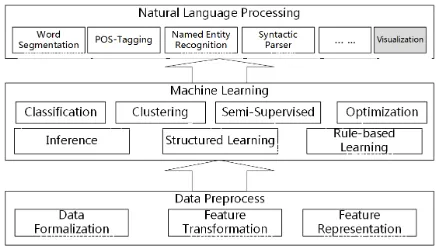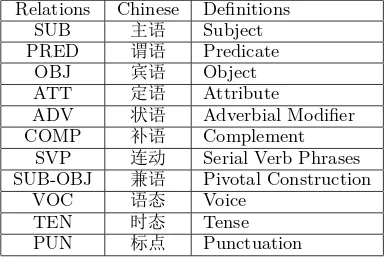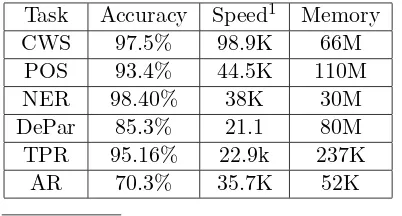FudanNLP: A Toolkit for Chinese Natural Language Processing
Xipeng Qiu, Qi Zhang, Xuanjing Huang
Fudan University, 825 Zhangheng Road, Shanghai, China xpqiu@fudan.edu.cn, qz@fudan.edu.cn, xjhuang@fudan.edu.cn
Abstract
The growing need for Chinese natural language processing (NLP) is largely in a range of research and commer-cial applications. However, most of the currently Chinese NLP tools or components still have a wide range of issues need to be further improved and developed. FudanNLP is an open source toolkit for Chinese natural lan-guage processing (NLP), which uses statistics-based and rule-based meth-ods to deal with Chinese NLP tasks, such as word segmentation, part-of-speech tagging, named entity recogni-tion, dependency parsing, time phrase recognition, anaphora resolution and so on.
1 Introduction
Chinese is one of the most widely used lan-guages in this world, and the proportion that Chinese language holds on the Internet is also quite high. Under the current circumstances, there are greater and greater demands for in-telligent processing and analyzing of the Chi-nese texts.
Similar to English, the main tasks in Chi-nese NLP include word segmentation (CWS), part-of-speech (POS) tagging, named en-tity recognition (NER), syntactic parsing, anaphora resolution (AR), and so on. Al-though the general ways are essentially the same for English and Chinese, the implemen-tation details are different. It is also non-trivial to optimize these methods for Chinese NLP tasks.
There are also some toolkits to be used for NLP, such as Stanford CoreNLP1, Apache
OpenNLP2, Curator3 and NLTK4. But these
toolkits are developed mainly for English and not optimized for Chinese.
In order to customize an optimized system for Chinese language process, we implement an open source toolkit, FudanNLP5, which is
written in Java. Since most of the state-of-the-art methods for NLP are based on statistical learning, the whole framework of our toolkit is established around statistics-based ods, supplemented by some rule-based meth-ods. Therefore, the quality of training data is crucial for our toolkit. However, we find that there are some drawbacks in currently most commonly used corpora, such as CTB (Xia, 2000) and CoNLL (Hajič et al., 2009) corpora. For example, in CTB corpus, the set of POS tags is relative small and some cate-gories are derived from the perspective of En-glish grammar. And in CoNLL corpus, the head words are often interrogative particles and punctuations, which are unidiomatic in Chinese. These drawbacks bring more chal-lenges to further analyses, such as informa-tion extracinforma-tion and semantic understanding. Therefore, we first construct a corpus with a modified guideline, which is more in ac-cordance with the common understanding for Chinese grammar.
In addition to the basic Chinese NLP tasks
1http://nlp.stanford.edu/software/corenlp.
shtml
2http://incubator.apache.org/opennlp/ 3http://cogcomp.cs.illinois.edu/page/
software_view/Curator
4http://www.nltk.org/
5http://fudannlp.googlecode.com
Figure 1: System Structure of FudanNLP
mentioned above, the toolkit also provides many minor functions, such as text classifi-cation, dependency tree kernel, tree pattern-based information extraction, keywords ex-traction, translation between simplified and traditional Chinese, and so on.
Currently, our toolkit has been used by many universities and companies for various applications, such as the dialogue system, so-cial computing, recommendation system and vertical search.
The rest of the demonstration is organized as follows. We first briefly describe our system and its main components in section 2. Then we show system performances in section 3. Sec-tion 4 introduces three ways to use our toolkit. In section 5, we summarize the paper and give some directions for our future efforts.
2 System Overview
The components of our system have three layers of structure: data preprocessing, ma-chine learning and natural language process-ing, which is shown in Figure 1. We will in-troduce these components in detail in the fol-lowing subsections.
2.1 Data Preprocessing Component In the natural language processing system, the original input is always text. However, the statistical machine learning methods often deal with data with vector-based representa-tion. So we firstly need to preprocess the input texts and transform them to the required for-mat. Due to the fact that text data is usually discrete and sparse, the sparse vector struc-ture is largely used. Similar to Mallet (Mc-Callum, 2002), we use the pipeline structure for a flexible transformation of various data.
The pipeline consists of several serial or par-allel modules. Each module, called “pipe”, is aimed at a single and simple function.
For example, when we transform a sentence into a vector with “bag-of-words”, the trans-formation process would involve the following serial pipes:
1. String2Token Pipe: to transform a string into word tokens.
2. Token2Index Pipe: to look up the word alphabet to get the indices of the words.
3. WeightByFrequency Pipe: to calculate the vector weight for each word accord-ing to its frequency of occurrence.
With the pipeline structure, the data pre-processing component has good flexibility, ex-tensibility and reusability.
2.2 Machine Learning Component
The outputs of NLP are often structured, so the structured learning is our core module. Structured learning is the task of assigning a structured labely to an input x. The labely can be a discrete variable, a sequence, a tree or a more complex structure.
To illustrate by a sample x, we define the feature asΦ(x,y). Thus, we can label xwith a score function,
ˆ
y=arg max
y F(w,Φ(x,y)), (1)
where w is the parameter of function F(·). The feature vector Φ(x,y) consists of lots of overlapping features, which is the chief benefit of a discriminative model.
For example, in sequence labeling, bothx=
x1, . . . , xL and y = y1, . . . , yL are sequences. For first-order Markov sequence labeling, the feature can be denoted as ϕk(yi−1, yi,x, i), where iis the position in the sequence. Then the score function can be rewritten as
ˆ
y=arg max
y F( L
∑
i=1
∑
k
wkϕk(yi−1, yi,x, i)), (2)
whereL is the length ofx.
Different algorithms vary in the definition of
F(·)is usually defined as a linear or exponen-tial family function. For example, in condi-tional random fields (CRFs) (Lafferty et al., 2001),F(·) is defined as:
Pw(y|x) = 1
Zw
exp(wTΦ(x,y)), (3)
where Zw is the normalization constant such
that it makes the sum of all the terms one. In FudanNLP, the linear function is univer-sally used as the objective function. Eq. (1) is written as:
ˆ
y=arg max
y <w,Φ(x,y)> . (4)
2.2.1 Training
In the training stage, we use the passive-aggressive algorithm to learn the model pa-rameters. Passive-aggressive (PA) algorithm (Crammer et al., 2006) was proposed for nor-mal multi-class classification and can be easily extended to structure learning (Crammer et al., 2005). Like Perceptron, PA is an online learning algorithm.
2.2.2 Inference
For consistency with statistical machine learning, we call the process to calculate the Eq.(1) as “inference”. In structured learning, the number of possible solutions is very huge, so dynamic programming or approximate ap-proaches are often used for efficiency. For NLP tasks, the most popular structure is sequence. To label the sequence, we use Viterbi dynamic programming to solve the inference problem in Eq. (4).
Our system can support any order of Viterbi decoding. In addition, we also implement a constrained Viterbi algorithm to reduce the number of possible solutions by pre-defined rules. For example, when we know the prob-able labels, we delete the unreachprob-able states from state transition matrix. It is very useful for CWS and POS tagging with sequence la-beling. When we have a word dictionary or know the POS for some words, we can get more accurate results.
2.2.3 Other Algorithms
Apart from the core modules of structured learning, our system also includes several tra-ditional machine learning algorithms, such as Perceptron, Adaboost, kNN, k-means, and so on.
2.3 Natural Language Processing Components
Our toolkit provides the basic NLP func-tions, such as word segmentation, part-of-speech tagging, named entity recognition, syn-tactic parsing, temporal phrase recognition, anaphora resolution, and so on. These func-tions are trained on our developed corpus. We also develop a visualization module to display-ing the output. Table 1 shows the output rep-resentation of our toolkit.
2.3.1 Chinese Word Segmentation Different from English, Chinese sentences are written in a continuous sequence of char-acters without explicit delimiters such as the blank space. Since the meanings of most Chi-nese characters are not complete, words are the basic syntactic and semantic units. There-fore, it is indispensable step to segment the sentence into words in Chinese language pro-cessing.
We use character-based sequence labeling (Peng et al., 2004) to find the boundaries of words. Besides the carefully chosen features, we also use the meaning of character drawn from HowNet(Dong and Dong, 2006), which improves the performance greatly. Since un-known words detection is still one of main chal-lenges of Chinese word segmentation. We im-plement a constrained Viterbi algorithm to al-low users to add their own word dictionary.
2.3.2 POS tagging
Chinese POS tagging is very different from that in English. There are no morphological changes for a word among its different POS tags. Therefore, most of Chinese words may have multiple POS tags. For example, there are different morphologies in English for the word “毁灭 (destroy)”, such as “destroyed”, “destroying” and “destruction”. But in Chi-nese, there is just one same form(Xia, 2000).
Input:
约翰来自华盛顿,他生于1980年。
John is from Washington, and he was born in 1980. Output:
.. ..
约翰 来自.. 华盛顿.. ,.. 他.. 生于.. 1980.. 年 。.. ..
John is from.. Washington.. .., he.. was born in.. 1980.. ... ..
PER VV.. LOC.. PU.. PRN.. NN.. PU..
..
1 2.. 3.. 4.. 5.. 6.. 7.. 8..
.
Root
. SUB
. CS:COO1
. OBJ
. PUN
.
SUB
.
OBJ
.
PUN
NER:
1 → PER
3 → LOC
AR:
5 → 1
TIME:
7 → 1980
[image:4.595.80.518.94.233.2]1 CS:COO means the coordinate complex sentence.
Table 1: Example of the output representation of our toolkit
location, organization and other proper name. Conversely, we merge the “VC” and “VE” into “VV” since there is no link verb in Chinese. Finally, we use a tag set with39 categories in total.
Since a POS tag is assigned to each word, not to each character, Chinese POS tag-ging has two ways: pipeline method or joint method. Currently, the joint method is more popular and effective because it uses more flex-ible features and can reduce the error propa-gation (Ng and Low, 2004). In our system, we implement both methods for POS tagging. Besides, we also use some knowledge to im-prove the performance, such as Chinese sur-name and the common suffixes of the sur-names of locations and organizations.
2.3.3 Named Entity Recognition
In Chinese named entity recognition (NER), there are usually three kinds of named enti-ties (NEs) to be dealt with: names of per-sons (PER) , locations (LOC) and organiza-tions (ORG). Unlike English, there is no obvi-ous identification for NEs, such as initial capi-tals. The internal structures are also different for different kinds of NEs, so it is difficult to build a unified model for named entity recog-nition.
Our NER is based on the results of POS tagging and uses some customize features to detect NEs. First, the number of NEs is very large and the new NEs are endlessly emerg-ing, so it is impossible to store them in dic-tionary. Since the internal structures are
rela-tively more important, we use language mod-els to capture the internal structures. Second, we merge the continuous NEs with some rule-based strategies. For example, we combine the continuous words “人民/NN大会堂/NN” into
“人民大会堂/LOC”.
2.3.4 Dependency parsing
Our syntactic parser is currently a depen-dency parser, which is implemented with the shift-reduce deterministic algorithm based on the work in (Yamada and Matsumoto, 2003). The syntactic structure of Chinese is more complex than that of English, and semantic meaning is more dominant than syntax in Chi-nese sentences. So we select the dependency parser to avoid the minutiae in syntactic con-stituents and wish to pay more attention to the subsequent semantic analysis. Since the structure of the Chinese language is quite dif-ferent from that of English, we use more effec-tive features according to the characteristics of Chinese sentences.
primary dependency relations in our guideline.
.. ..
想 去.. 合欢山.. 赏.. 雪.. 吗.. ?.. ..
want togo to.. Hehuanshan.. to see.. the snow.. .. ?.. ..
VV VV.. NR.. VV.. NN.. SP.. PU.. .
Root
. COMP
. ADV
. COMP
. COMP
.
COMP
.
UNK
Figure 2: Dependency Tree in CoNLL Corpus
.. ..
想 去.. 合欢山.. 赏.. 雪.. 吗.. ?.. ..
want togo to.. Hehuanshan.. to see.. the snow.. .. ?.. ..
MD VV.. LOC.. VV.. NN.. SP.. PU.. .
Root
. ADV
. OBJ
. OBJ
.
OBJ
. VOC
[image:5.595.79.285.89.173.2]. PUN
Figure 3: Dependency Tree in Our Corpus
Relations Chinese Definitions
SUB 主语 Subject
PRED 谓语 Predicate
OBJ 宾语 Object
ATT 定语 Attribute
ADV 状语 Adverbial Modifier
COMP 补语 Complement
SVP 连动 Serial Verb Phrases
SUB-OBJ 兼语 Pivotal Construction
VOC 语态 Voice
TEN 时态 Tense
[image:5.595.80.285.229.315.2]PUN 标点 Punctuation
Table 2: Some primary dependency relations
2.3.5 Temporal Phrase Recognition and Normalization
Chinese temporal phrases is more flexible than English. Firstly, there are two calendars: Gregorian and lunar calendars. Both of them are frequently used. Secondly, the forms of same temporal phrase are various, which often consists of Chinese characters, Arabic numer-als and English letters, such as“早上 10点”
and “10:00 PM”.
Different from the general process based on machine learning, we implement the time phrase recognizer with a rule-based method. These rules include 376 regular expressions and nearly a hundred logical judgments.
After recognizing the temporal phrases, we normalize them with a standard time format.
For a phrase indicating a relative time , such as “一年后” and “一小时后”, we first find the base time in the context. If no base time is found, or there is also no temporal phrase to indicate the base time (such as “明天”), we set the base time to the current system time. Table 3 gives examples for our temporal phrase recognition module.
Input:
08年北京举行奥运会,8月8号开幕。四年后的七月 二十七日,伦敦奥运开幕。
The Beijing Olympic Games took place from Au-gust 8, 2008. Four years later, the London Olympic Games took place fromJuly 21.
今天我很忙,晚上9点才能下班。周日也要加班。 I’m busytoday, and have to come off duty after9:00 PM. And I also have to workthis Sunday.
Output:
08年(2008) 2008
8月8号(August 8) 2008-8-8
七月二十七日(July 21) 2012-7-27
今天(today) 2012-2-221
晚上9点(9:00 PM) 2012-2-22 21:00
周日(this Sunday) 2012-2-26
1 The base time is 2012-02-22 10:00AM.
Table 3: Examples for Temporal Phrase Recognition
2.3.6 Anaphora Resolution
Anaphora resolution is to detect the pro-nouns and find what they are referring to. We first find all pronouns and entity names, then use a classifier to predict whether there is a relation between each pair of pronoun and entity name. Table 4 gives examples for our anaphora resolution module.
Input:
牛津大学创建于1167年。它位于英国牛津城。这个 大学培育了好多优秀的学生。
Oxford Universityis founded in 1167. Itis located in Oxford, UK.The universityhas nurtured a lot of good students.
Output:
它(It) 牛津大学 这 个 大 学 (The
university)
牛津大学(Oxford University)
Table 4: Examples for Anaphora Resolution
3 System Performances
[image:5.595.85.280.367.496.2]named entity recognition (NER) and de-pendency parser(DePar), Temporal Phrase Recognition (TPR) and Anaphora Resolution (AR). We use 5-fold cross validation on our developed corpus. The corpus includes65,745
sentences and 959,846 words. The perfor-mances are shown in Table 5.
Task Accuracy Speed1 Memory CWS 97.5% 98.9K 66M
POS 93.4% 44.5K 110M NER 98.40% 38K 30M DePar 85.3% 21.1 80M TPR 95.16% 22.9k 237K
AR 70.3% 35.7K 52K
1 characters per second. Test environment:
[image:6.595.82.283.166.274.2]CPU 2.67GHz, JRE 7.
Table 5: System Performances
4 Usages
We provide three ways to use our toolkit. Firstly, our toolkit can be used as library. Users can call application programming inter-faces (API) in their own applications.
Secondly, users can also invoke the main NLP modules to process the inputs (strings or files) from the command line directly.
Thirdly, the web services are provided for platform-independent and language-independent use. We use a REST (Represen-tational State Transfer) architecture, in which the web services are viewed as resources and can be identified by their URLs.
5 Conclusions
In this demonstration, we have described the system, FudanNLP, which is a Java-based open source toolkit for Chinese natural lan-guage processing. In the future, we will add more functions, such as semantic parsing. Be-sides, we will also optimize the algorithms and codes to improve the system performances.
Acknowledgments
We would like to thank all the people6
involved with our FudanNLP project. This work was funded by NSFC (No.61003091
6https://code.google.com/p/fudannlp/wiki/
People
and No.61073069) and 973 Program (No.2010CB327900).
References
K. Crammer, R. McDonald, and F. Pereira. 2005. Scalable large-margin online learning for struc-tured classification. In NIPS Workshop on
Learning With Structured Outputs. Citeseer.
Koby Crammer, Ofer Dekel, Joseph Keshet, Shai Shalev-Shwartz, and Yoram Singer. 2006. On-line passive-aggressive algorithms. Journal of
Machine Learning Research, 7:551–585.
Z. Dong and Q. Dong. 2006. Hownet And the
Computation of Meaning. World Scientific
Pub-lishing Co., Inc. River Edge, NJ, USA.
J. Hajič, M. Ciaramita, R. Johansson, D. Kawa-hara, M.A. Martí, L. Màrquez, A. Meyers, J. Nivre, S. Padó, J. Štěpánek, et al. 2009. The CoNLL-2009 shared task: Syntactic and seman-tic dependencies in multiple languages. In Pro-ceedings of the Thirteenth Conference on Com-putational Natural Language Learning: Shared Task, pages 1–18. Association for Computa-tional Linguistics.
John D. Lafferty, Andrew McCallum, and Fer-nando C. N. Pereira. 2001. Conditional ran-dom fields: Probabilistic models for segmenting and labeling sequence data. In Proceedings of the Eighteenth International Conference on
Ma-chine Learning.
Andrew Kachites McCallum. 2002. Mal-let: A machine learning for language toolkit. http://mallet.cs.umass.edu.
H.T. Ng and J.K. Low. 2004. Chinese part-of-speech tagging: one-at-a-time or all-at-once? word-based or character-based. In Proceedings
of EMNLP, volume 4.
F. Peng, F. Feng, and A. McCallum. 2004. Chi-nese segmentation and new word detection us-ing conditional random fields. Proceedings of the 20th international conference on Computational Linguistics.
F. Xia, 2000. The part-of-speech tagging guidelines
for the penn chinese treebank (3.0).
H. Yamada and Y. Matsumoto. 2003. Statis-tical dependency analysis with support vector machines. In Proceedings of the International
Workshop on Parsing Technologies (IWPT),
volume 3.



